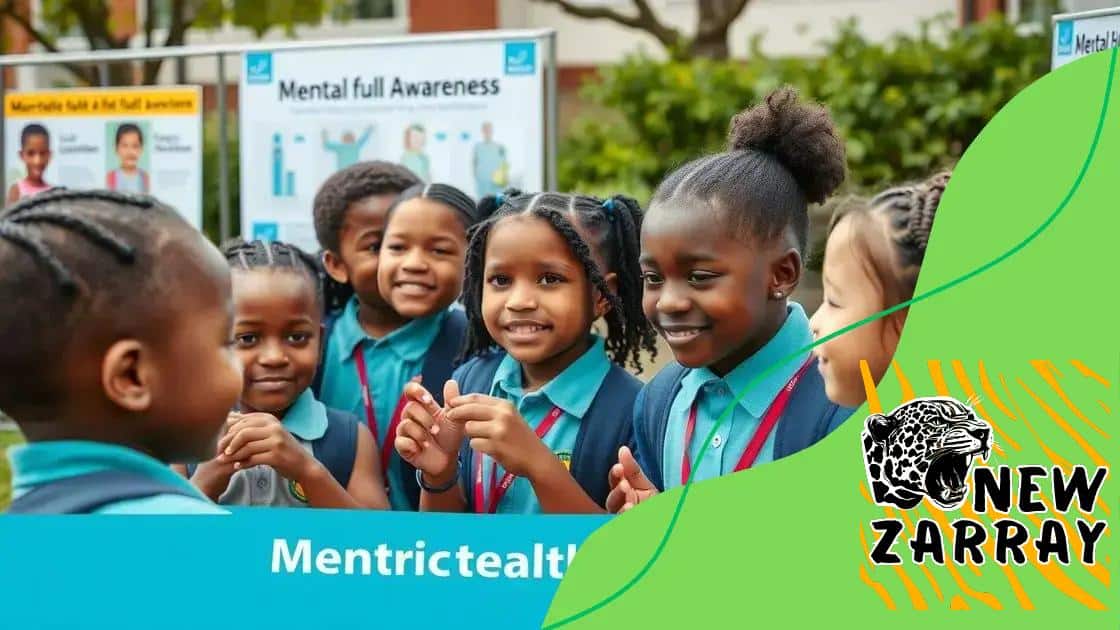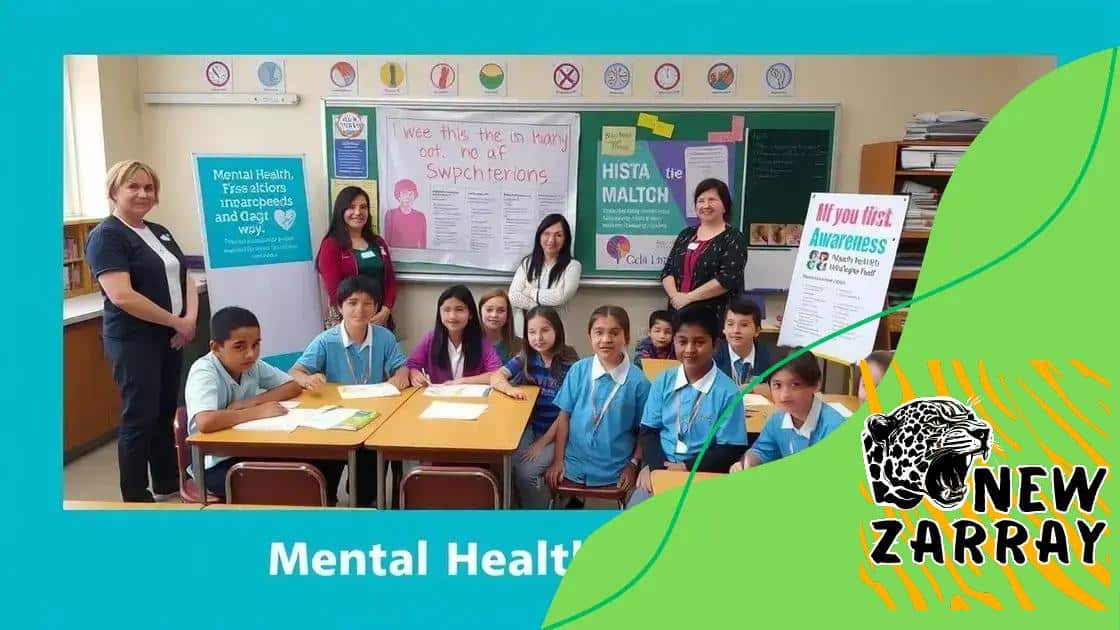Mental health awareness campaigns in schools: why they matter

Mental health awareness campaigns in schools are vital for promoting student well-being, encouraging open discussions, and providing resources that foster a supportive environment for addressing mental health issues.
Mental health awareness campaigns in schools are more than just educational tools; they’re lifelines for students. Ever thought about the weight of mental health on a child’s educational journey? Let’s dive into why these campaigns matter.
Understanding the importance of mental health
Understandably, mental health plays a vital role in our lives. It affects how we think, feel, and act. In schools, promoting mental health awareness can create a supportive environment for students. A focus on mental health helps students manage stress and improve their overall well-being.
Why Is Mental Health Important?
Mental health influences many aspects of a student’s life. Good mental health can lead to:
- Better Academic Performance: Students with sound mental health can concentrate better and learn more effectively.
- Improved Relationships: Healthy minds lead to healthier interactions with peers and teachers.
- Enhanced Emotional Resilience: Understanding and coping with emotions creates stronger individuals.
When students struggle with mental health issues, it can lead to serious consequences. They may face difficulties in school, have trouble making friends, or even engage in risky behaviors. Addressing these challenges early on can make a profound difference.
Understanding Mental Health in Students
Often, young people hide their feelings or don’t know how to express them. Schools can step in by providing resources and encouraging open discussions. This support helps students understand that it’s okay to seek help.
Furthermore, integrating mental health awareness into school programs fosters a culture of compassion. Teachers and staff should be trained to recognize the signs of distress and provide assistance. This proactive approach can transform the school environment.
Types of awareness campaigns
Awareness campaigns play a crucial role in promoting mental health among students. Different types of campaigns cater to diverse needs and help create a supportive environment in schools. Let’s explore some effective types of awareness campaigns.
Informational Campaigns
Informational campaigns focus on sharing vital facts about mental health. They often include posters, brochures, and presentations designed to educate students about:
- Common mental health issues: Understanding anxiety, depression, and stress can empower students to seek help.
- Signs of emotional distress: Recognizing the symptoms can lead to early intervention.
- Resources available: Sharing contacts for counselors or hotlines helps students know where to go for support.
These campaigns ensure that students have the knowledge they need to take care of their mental well-being.
Interactive Campaigns
Engaging students through interactive campaigns is another effective approach. These activities encourage participation and can include workshops or role-playing scenarios. Such engagement promotes understanding and reduces stigma. For instance, students can:
- Participate in workshops: Workshops can teach coping strategies and stress management.
- Join peer support groups: Connecting with other students creates a sense of community and shared experience.
- Attend mental health fairs: These events can showcase various mental health organizations and provide resources.
Interactive campaigns allow students to experience the importance of mental health firsthand, making the information more relatable.
Social Media Campaigns
Today, social media is a powerful tool for raising awareness. Schools can harness platforms like Instagram, TikTok, and Twitter to reach students where they are most active. A few strategies include:
- Sharing testimonials: Highlighting personal stories can inspire students to open up about their struggles.
- Using hashtags: Promoting specific hashtags can create a larger conversation about mental health.
- Creating informative videos: Short and engaging videos can deliver important messages quickly and effectively.
Social media campaigns effectively spread awareness and encourage students to engage and share information.
How schools can implement programs

Schools play a crucial role in fostering mental health awareness programs. Implementing these programs can create a more supportive and understanding environment for students. Here are effective strategies schools can adopt to implement these initiatives.
Developing a Comprehensive Plan
Creating a structured plan is the first step. It helps schools identify the goals and necessary resources for the program. Important aspects include:
- Assessing student needs: Collect data on the mental health challenges students face to tailor programs effectively.
- Setting clear objectives: Defining what the school aims to achieve can guide the implementation process.
- Allocating resources: Determining the budget and personnel will ensure that the program runs smoothly.
A well-thought-out plan sets the foundation for successful mental health initiatives.
Training Staff and Faculty
Educators have a significant impact on students’ lives. Training staff to recognize and address mental health issues is vital. This can involve:
- Workshops: Offer regular training sessions focusing on mental health awareness and support strategies.
- Creating resource guides: Provide materials that outline mental health resources within the school.
- Encouraging open communication: Foster an environment where students feel comfortable discussing their mental health with teachers.
Staff training empowers faculty to be proactive and supportive allies for their students.
Engaging Students and the Community
Involving students and the broader community increases the program’s effectiveness. Schools can encourage participation through:
- Student-led initiatives: Empower students to lead campaigns, offering a relatable voice in mental health discussions.
- Community partnerships: Collaborate with local mental health organizations to provide resources and expertise.
- Parent involvement: Engage parents in workshops and meetings to promote a unified approach to mental health.
This collaboration fosters a supportive network around students, enhancing the program’s impact.
Involving parents and the community
Involving parents and the community is essential in fostering mental health awareness in schools. When families and local organizations participate, they enhance the support system for students, making mental health initiatives more effective.
Building Strong Communication Channels
Open lines of communication between schools, parents, and the community create a collaborative environment. This can be achieved through:
- Regular updates: Keeping parents informed about programs and resources ensures they are engaged.
- Workshops: Offering sessions for parents can help them understand mental health issues and how to support their children.
- Feedback opportunities: Encouraging feedback from parents allows schools to improve their mental health programs.
Communication builds trust and ensures parents feel valued in their children’s education.
Engaging Community Resources
Connecting with local organizations can provide additional support for mental health initiatives. Schools can:
- Partner with mental health professionals: Collaborating with counselors or therapists can provide resources and expertise.
- Host community events: Organizing fairs or informational nights allows families to learn more about mental health resources.
- Promote local support groups: Informing parents about support groups helps them find community support.
By engaging community resources, schools can further enhance their mental health programs, ensuring students have access to comprehensive support.
Encouraging Parent Involvement
Parents play a critical role in their child’s mental health journey. Schools can encourage involvement through:
- Volunteering opportunities: Parents can contribute by volunteering at school events focused on mental health.
- Creating parent committees: Involving parents in decision-making processes fosters a sense of ownership and commitment.
- Hosting parenting classes: Providing education on child development and mental health can empower parents.
When parents are involved, it sends a strong message to students that mental health is a priority. Schools can create an environment where children feel supported both at home and at school.
Measuring the impact of campaigns
Measuring the impact of mental health awareness campaigns is crucial for understanding their effectiveness. Schools must evaluate these programs to determine what works and where improvements are needed. By assessing the outcomes, schools can better support their students.
Setting Clear Goals and Objectives
Before launching a campaign, it’s important to set specific objectives. Clear goals allow schools to measure success accurately. Some common goals might include:
- Increased knowledge: Assess if students understand the key concepts related to mental health.
- Improved attitudes: Evaluate whether students’ perceptions of mental health issues have become more positive.
- Greater help-seeking behavior: Monitor if students are more likely to reach out for support.
By defining clear goals, schools can track progress and make data-driven decisions.
Collecting Data
Data collection is vital in measuring the impact of campaigns. Schools can utilize various methods:
- Surveys: Conducting pre- and post-campaign surveys helps gauge changes in awareness and attitudes.
- Focus groups: Engaging students in discussions can provide deeper insights into their experiences and feedback.
- Behavioral data: Tracking the number of students seeking mental health services can indicate the campaign’s success.
Using multiple data sources ensures a comprehensive understanding of the campaign’s impact.
Analyzing Results
Once data is collected, it’s important to analyze the results thoroughly. This can reveal trends, successes, and areas needing improvement. For example, if surveys show a rise in awareness but little change in help-seeking behaviors, it may indicate the need for more accessible resources. Schools should:
- Compare data over time: Look for patterns by comparing results before and after each campaign.
- Engage stakeholders: Share findings with staff, students, and parents to encourage collaboration in making improvements.
- Adjust future campaigns: Make necessary changes to ensure future campaigns better meet the needs of the students.
Thorough analysis allows schools to refine their approaches and increase the effectiveness of future mental health awareness campaigns.
\n
FAQ – Questions about Mental Health Awareness Campaigns in Schools
What are the main goals of mental health awareness campaigns in schools?
The main goals include increasing student awareness, improving attitudes towards mental health, and encouraging help-seeking behavior.
How can parents get involved in mental health programs at school?
Parents can get involved by participating in workshops, volunteering for events, and joining committees to support mental health initiatives.
What methods are used to measure the impact of mental health campaigns?
Common methods include surveys, focus groups, and analyzing behavioral data such as counseling requests from students.
Why is community involvement important for school mental health programs?
Community involvement strengthens support networks and resources, providing a more comprehensive approach to addressing students’ mental health needs.





